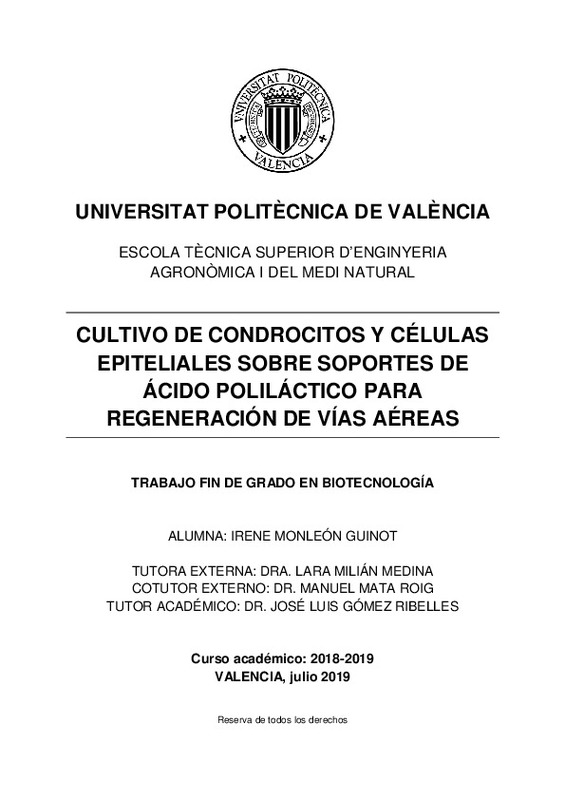|
Resumen:
|
[ES] Objetivos: Las vías aéreas cumplen un papel muy importante en el organismo ya que son
las responsables tanto de llevar el aire a los pulmones como de acondicionarlo. El cartílago
tiene una función esencial de soporte ...[+]
[ES] Objetivos: Las vías aéreas cumplen un papel muy importante en el organismo ya que son
las responsables tanto de llevar el aire a los pulmones como de acondicionarlo. El cartílago
tiene una función esencial de soporte mientras que la mucosa respiratoria es la encargada
del aclaramiento mucociliar. Enfermedades como la estenosis afectan a estas estructuras
impidiendo la correcta realización de sus funciones y resultando en graves consecuencias
para quienes las sufren, además de que los tratamientos actuales no son efectivos. Las
técnicas de ingeniería tisular son prometedoras para la reconstrucción de este tipo de
defectos, por ello en este trabajo se plantea el uso del ácido poliláctico como soporte en
estrategias de regeneración del cartílago y la mucosa de las vías aéreas.
Metodología: En primer lugar, se caracterizó la estructura, citotoxicidad y propiedades
mecánicas de los soportes de ácido poliláctico. Posteriormente, se sembraron condrocitos
primarios sobre scaffolds de ácido poliláctico impresos en 3D con y sin hidrogeles, y se
evaluó mediante marcaje fluorescente la morfología y la expresión de colágeno de tipo I, de
tipo II y agrecano. También se sembraron células epiteliales primarias y las líneas celulares
A549 y H460 sobre membranas electrohiladas de ácido poli-L-láctico con y sin colágeno, y
se analizó mediante fluorescencia la proliferación y morfología, así como la expresión de
genes relacionados con la mucosa respiratoria (CDH1, CK20 y MUC5AC) mediante Real
Time PCR.
Resultados: Los soportes de ácido poliláctico resultaron ser no citotóxicos además de que
mostraron propiedades mecánicas similares a los de la tráquea, con un Módulo de Young de
entre 2,6 ± 0,1 y 3,6 ± 0,2 MPa según el espesor. Por otra parte, los condrocitos sembrados
en los scaffolds de PLA expresaron proteínas propias del cartílago hialino como colágeno II
y agrecano principalmente cuando se combinó el scaffold con el hidrogel de alginato y
agarosa. Además, las células epiteliales mostraron una proliferación adecuada tapizando las
membranas con y sin colágeno, y en el caso de las A549 y las células epiteliales primarias,
mostraron expresión de CDH1, lo que significa que sí que tienen características de epitelio.
Conclusiones: Los resultados obtenidos permiten concluir que el uso de ácido poliláctico
como soporte para condrocitos y células epiteliales presenta una potencial capacidad para la
regeneración de vías aéreas.
[-]
[EN] Objectives: The airways play a very important role in the organism since they are
responsible for both carrying the air to the lungs and conditioning it. Cartilage has an
essential support function while the respiratory ...[+]
[EN] Objectives: The airways play a very important role in the organism since they are
responsible for both carrying the air to the lungs and conditioning it. Cartilage has an
essential support function while the respiratory mucosa is responsible for mucociliary
clearance. Diseases such as stenosis affect these structures, preventing the proper
performance of their functions and resulting in serious consequences for those who suffer
them, in addition to the fact that current treatments are not effective. Tissue engineering
techniques are promising for the reconstruction of this type of defects, so in this project the
use of polylactic acid as a support in regeneration strategies of the cartilage and the mucosa
of the airways is considered.
Methodology: Firstly, the structure, cytotoxicity and mechanical properties of the polylactic
acid supports were characterized. Subsequently, primary chondrocytes were seeded on 3D
printed polylactic acid scaffolds with and without hydrogels, and the morphology and
expression of type I, type II and aggrecan collagen was evaluated by fluorescent labeling.
Primary epithelial cells and the A549 and H460 cell lines were also seeded onto
electrohilated membranes of poly-L-lactic acid with and without collagen, and proliferation
and morphology were analyzed by fluorescence, as well as the expression of genes related
to the respiratory mucosa ( CDH1, CK20 and MUC5AC) by Real Time PCR.
Results: The polylactic acid scaffolds were found to be non-cytotoxic, in addition to showing
mechanical properties similar to those of the trachea, with a Young's modulus between 2.6 ±
0.1 and 3.6 ± 0.2 MPa depending on the thickness. On the other hand, the chondrocytes
grown in the PLA scaffolds expressed hyaline cartilage proteins such as collagen II and
aggrecan mainly when the scaffold was combined with the alginate and agarose hydrogel. In
addition, the epithelial cells showed an adequate proliferation on membranes with and
without collagen, and in the case of the A549 and the primary epithelial cells, they showed
expression of CDH1, which means that they do have epithelial characteristics.
Conclusions: The results obtained allow us to conclude that the use of polylactic acid as a
scaffold for chondrocytes and epithelial cells presents a potential capacity for the
regeneration of airways.
[-]
|







